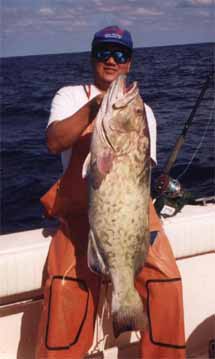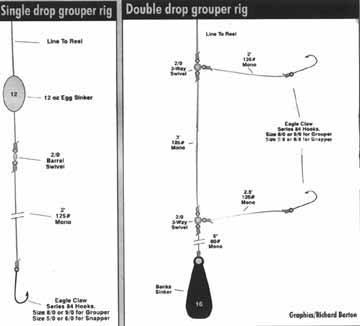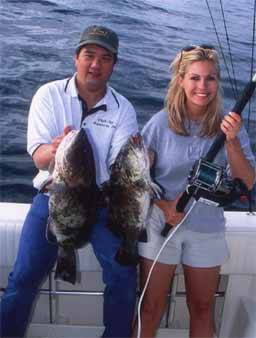Anthony Ng: Top Man for the Bottom
By Jerry Dilsaver
Anthony Ng (pronounced "ing") of Winterville, NC is an offshore bottom fisherman with few equals. At times it seems as though he can almost smell grouper. His very successful pursuit of them is the main reason that he became involved in the tackle industry. From his experiences with tackle, he has zeroed in on a few specific items that are designed for the serious offshore bottom fisherman and included them in the product line for his company, Fish-Ng Accessories. And he hasn't let success get in the way of his fishing.
Even though Anthony Ng is a licensed commercial fisherman, he is always willing to offer tips to recreational fishermen. Many successful grouper fishermen owe credit for at least part of their success to him. I am a member of that group and am thrilled to be able to pass on some of his techniques and knowledge. He has spoken at various seminars and fishing schools across the years and will again be one of the instructors at the Carolina Adventure Saltwater Fishing School this spring.
Like many other fishermen, Ng started off catching spots, croakers and the other inshore bottom fish. Those early trips were with his father and brother, who both still like to go occasionally. Over the past 20 years, Ng has refined his approach and techniques, but is still willing to experiment with ideas that appear promising. Through all this time, he says he has never thought of fishing as a job. He still enjoys catching fish as much as he ever has.
While Ng's favorite fish to catch is grouper, he has caught a wide variety of fish over the years. He said that one of the attractions of bottom fishing is, "you just never know what you may hook out there."
His list of unusual catches shows this. He said his most unusual catch was a trumpet fish, but he has caught frog fish, spiny lobster, wahoo, tuna, kings, sharks of many species, and eve a sailfish while drifting a light line.
Ng said that the key to successful bottom fishing is patience and just using good common sense. An example would be a situation where you are marking a large concentration of fish along a piece of structure and the fish aren't biting. Changing baits, trying to find something that turns them on, and/or waiting for them to start feeding, will usually move that trip to the successful column.
The equipment for successful offshore bottom fishing is pretty simple. First you need a good stable platform. If the boat is rocking badly, it's difficult to distinguish bites. Larger, wide beam boats will help calm the seas considerably. Ng uses a 30-foot Grady White center console and compliments it as being near perfect for the job. Of course powering such a large boat requires big motors. He said that a pair of 250 Horsepower Yamaha outboards does the job admirably and with reasonable fuel economy. He doesn't overnight on the water, so some speed is required to get to and from the offshore grouper holes and still have some good fishing time.
For reels, Ng recommends the Penn 4/0 and 6/0 senators. They are durable reels that can withstand lots of use. The reels with the black side plates (113 and 114) have a lower retrieve ratio and generate more power. The reels with the red side plates (113H and 114H) have a faster retrieve rate but can require more effort to wind, especially on a large fish. The Precision Electric Reels will attach to both series and also the 9/0 or 115 Senator.
Ng suggests that most fishermen will be well suited to use a 5-1/2 or 6 foot stand up style rod. These rods have a soft tip to help detect bites, but quickly stiffen and provide lots of lifting power. He suggests completing the outfit by using an 80 pound or heavier top shot of one of the super braid lines. The lines are smaller in diameter, so they cut through any current easily, and have virtually no stretch. This allows you to feel even the subtlest strike. Ng prefers Tuff Line by Western Filament. Breaking out in a grin, he said it's so sensitive that he can occasionally feel a fish swim by.
There are two basic rigs that Ng uses all of the time. One is a two-drop rig that is basically just an over-sized bottom rig. He starts by connecting a pair of 2/0 three-way swivels with a piece of 125 pound mono so that they are three feet apart. To one of the three-way swivels he ties a short piece of 80 pound mono and then makes a loop in the other end to attach to a banks style sinker. This allows the sinker to break away, if snagged, without losing the entire rig. To the other eye of this three-way swivel, he attaches a 2-1/2 foot piece of 125 pound mono. This is the bottom of the rig. At the other three-way swivel, he attaches a two foot piece of 125 pound mono. The other eye of this swivel is used to tie the rig to the line from the reel. For grouper, Ng attaches either 8/0 or 9/0 hooks to the short pieces of mono. For snapper he downsizes the hooks to 5/0 or 6/0. His favorite hook is an Eagle Claw series 84 which is offset and bronze.
The other rig is much simpler. It uses a 2 foot piece of 125 pound mono that has the hook on one end and a 2/0 barrel swivel on the other. An egg sinker is placed on the line from the reel, which is then connected to the other eye of the barrel swivel. The hook sizes and style remain the same. If the fish are picky or skittish, fluorocarbon may be substituted for the mono. Heavy sinkers are needed to get the rigs down in deeper water. The single hook rig will usually work with sinkers from 8 to 16 ounces. The double hook rig may require as much as 24 ounces at times. Ng says that if a 24 ounce sinker cannot hold the bottom, he looks for somewhere else to fish.
Upon arriving at his fishing destination, Ng looks for concentrations of fish. A good color scope is of prime importance in locating the fish. Grouper, along with many other species, will mark heavily on the bottom. Snapper will sometimes hovering just off the bottom. Once the fish are found, it is of the utmost importance to anchor so that your baits are dropping to them. Ng said that sometimes getting anchored just right may take several attempt, but to keep trying and get it right. He added that the fish are concentrated and that missing them by even a few feet will mean the difference between success and failure.
Ng said that for grouper, big chunks of oily bait are the way to go. He likes menhaden, herring, bluefish, sardines and cigar minnows, and will even sometimes use squid. His idea is that the smaller fish will immediately start to pick at the bait, releasing the oil and small particles of the bait into the current on the bottom.
The feeding activity of the smaller fish and the smell of dinner combine to excite the grouper into leaving his hole and feeding. He said that when things are slow, he would grind some chum, and then lower it down from a rod on the bow. The chum is used to stimulate the action. Ng says that big pieces of bait are needed to last long enough for the grouper to have something to bite once he emerges.
With this in mind, Ng cautioned not to react to the machinegun-like bite of the smaller fish. It is rare to hook one and continuous jerking tends to pull the bait off the hook. The grouper bite is often a very subtle, solid pull that just seems to be a sudden extra weight on the line. It usually takes some time and experience to develop the "feel" for a grouper bite. Snapper are usually a softer feel of the rat-tat-tat bite of the grunts and smaller fish. However, when on a strong "feed", both grouper and snapper will occasionally strike ferociously.
 Ng said to fight bottom fish to the boat with the same pump and wind action as w2ith any fish. He added that the first 10 feet of the fight are the most critical. This is when the fish, especially grouper, is the strongest and trying to get back to cover. Ng said, "You must keep a grouper from getting back to his house if you are going to catch him." The same goes, to a lesser degree, for all the bottom dwellers.
Ng said to fight bottom fish to the boat with the same pump and wind action as w2ith any fish. He added that the first 10 feet of the fight are the most critical. This is when the fish, especially grouper, is the strongest and trying to get back to cover. Ng said, "You must keep a grouper from getting back to his house if you are going to catch him." The same goes, to a lesser degree, for all the bottom dwellers.
Ng said that with the exception of red grouper, fall through spring is the best fishing time for most offshore bottom fish. There are seasons and limits that must be observed. Although many of the bottom dwellers don't get the press the pelagic species do, Anthony Ng has made a hobby (and living) on being on top of the bottom.
Precision Electric Reels are manufactured by Fish-Ng Accessories. They are designed and built to handle continuous hard use by commercial and serious recreational fishermen. In addition to targeting snapper and grouper, they have been tested as kite reels and on the giant bluefin tuna that have been visiting the Carolina coast for the past few years. Precision Electric Reels are manufactured to attach to the Penn Senator reel series and to be powered by the boat or a 12 volt battery. They also have a model for some of the Penn GTI Series reels. Another smaller series of electric reels, "John's Electric Reels" are distributed by Fish-Ng Accessories. These are much smaller electric reels that are designed to fit the Abu Garcia Ambassadeur baitcasting reels in the 5500 and 6500 sizes. There is also a John's Reel to fit the Zebco 444 series spincast reel. For increased portability The John's Electric reels are powered by a 6-volt battery pack that is attached to a waist belt.
Re-printed with permission from Carolina Adventure Magazine


